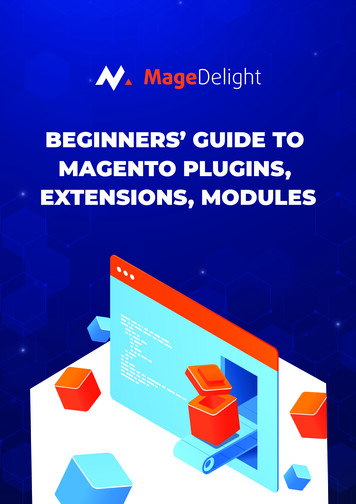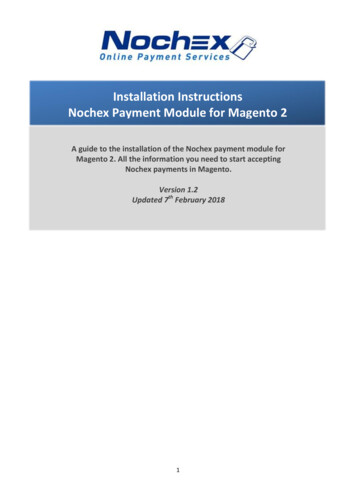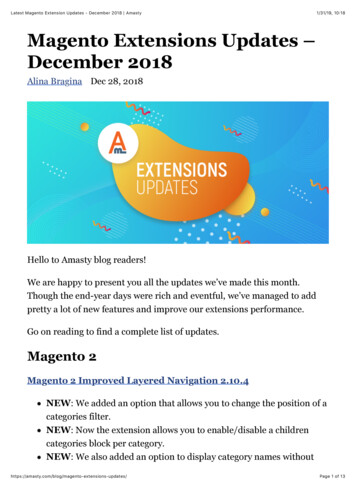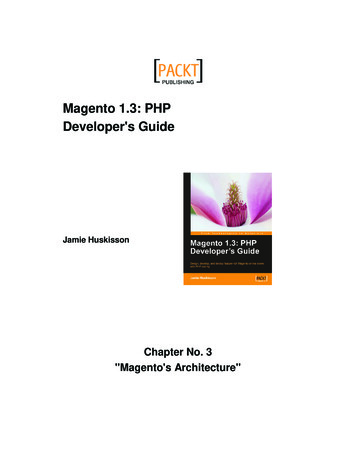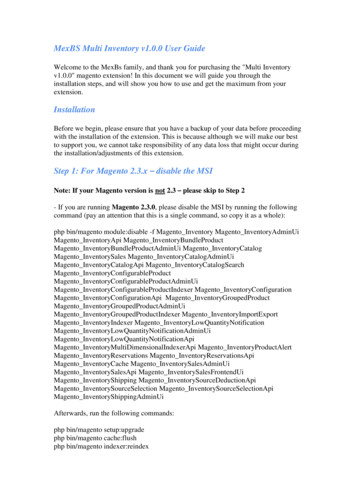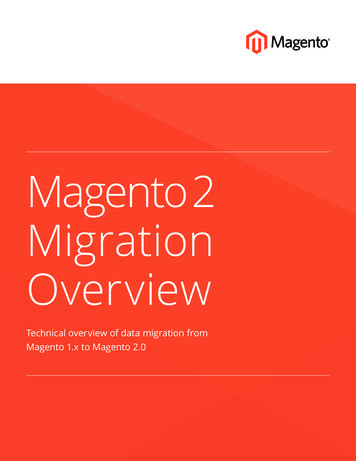
Transcription
Magento 2MigrationOverviewTechnical overview of data migration fromMagento 1.x to Magento 2.0
Table of Contents01INTRODUCTION09 HOW MIGRATION WORKS02High-Level Data Migration Roadmap09Terms Used02Architectural Overview09Disclaimer09Conceptial Overview10What Needs to be Manually Migrated11DATABASE CONFIGURATION ANDMAPPING FILES12Configuration File13Mapping Files03BEST PRACTICES AND BENCHMARKING03Best Practices and Recommendations03Benchmarking Estimates04 CREATING A MIGRATION PLAN04 Preconditions: Before You Run theMigration Tool04 Step 1: Review Your Current Site05Step 2: Capacity Planning06Step 3: Build and Test Magnto 207Step 4: Start Your Migration08Step 5: Incremental Updates08Step 6: Go LiveMagento 2 Migration Overview09 SUMMARYPage 2
IntroductionWe’re pleased you’re considering moving from the world’s #1 eCommerce platform—Magento 1.x—to theeCommerce platform for the future, Magento 2. We’re also excited to share the details about this process,which we refer to as migration.Magento 2 migration involves four components: data, extensions, themes, and customizations.DataWe’ve developed the Magento 2 Data Migration Tool to help you efficientlyport all of your key product, customer, and order data, store configurations,promotions and more to Magento 2. This paper provides information on the tooland best practices for using it to migrate your data.ExtensionsWe are actively working with the Magento development communityto help ensure the most widely used extensions will be updated, vetted, andavailable on Magento Connect when Magento 2 becomes generally available.More information on developing extensions for Magento 2 is available in theMagento 2 Extension Developer Guide.Themes and CustomizationsMagento 2 uses several new approaches and technologies that give merchantsan unmatched ability to create innovative shopping experiences and scale to newlevels. To take advantage of these advances, developers will need to make changesto their themes and customizations. Documentation is available online for creatingMagento 2 themes, layouts, and customizations.Magento 2 Migration OverviewPage 1
Just like an upgrade between 1.x versions (for example, from Enterprise Edition 1.12 to EnterpriseEdition 1.14) , the level of effort to migrate from Magento 1.x to Magento 2.0 depends upon howyou have built your site and its level of customization.Initial estimates indicate that an average Magento 2 migration is only about 20% larger than a Magento1.x upgrade. Over the coming months, as we proceed with testing and the merchant beta program,we will be able to refine this number so you can plan your budgets and timelines.High-Level Data Migration RoadmapAs mentioned previously, the primary focus of this paper is on the data migration process betweenMagento 1.x and Magento 2.0. To assist you with your migration, Magento is creating the Magento 2Migration Tool, a data migration command-line interface (CLI) tool with auxiliary verification, progresstracking, logging, and testing functions that allows direct data copying from a Magento 1.x database to aMagento 2 database. The tool is expected to be available by Q3 2015 and it efficiently and reliably migratesall core Magento data entities and any custom data entities that do not change between versions.The Migration Tool will support the following Magento versions: Community Edition (CE) 1.6, 1.7, 1.8, and 1.9 Enterprise Edition (EE) 1.11, 1.12, 1.13, and 1.14Architectural OverviewAfter considering several alternatives, we decided the most efficient way to migrate is usingextract, transform, and load (ETL) because it migrates almost everything as quickly as possiblewhile incurring the least amount of downtime of all options we considered. To help migratecustomized data, we use declarative language in our database mapping files. We also use migration stepsto make it easier to write complex code for your custom needs. Mapping files and migration steps arediscussed here.Magento 2 Migration OverviewPage 2
Best Practices andBenchmarkingThis section provides our best information about how to speed up and simplify your migration,and provides guidance about how much time you can expect migration to require.Best Practices and Recommendations Migrate data from a replicated Magento 1.x database instance. Remove outdated and redundant data from your Magento 1.x database (for example, you couldremove logs, order quotes, recently viewed or compared products, visitors, event-specificcategories, promotional rules, and so on). Stop all administrative activity on both Magento 1.x and Magento 2.0 during your migrationtest runs and during the actual data migration (including configuration changes; and maintainingcustomers, orders, and inventory). For Magento Enterprise Edition, archive unarchived orders.Benchmarking EstimatesMigration Tested on Systems: Environment: Virtual Box VM, CentOS 6, 2.5Gb RAM, CPU 1 core 2.6GHz Database had 177k products, 355k orders, 214k customersPerformance Results: Settings migration time: 10 mins Data migration time: 9 hrs (all data except URL Rewrites, 85% of total data) Site downtime estimate: A few minutes to reindex and change DNS settings. Additional timerequired to “warm up” the page cache.Magento 2 Migration OverviewPage 3
Creating a Migration PlanTo have a successful migration, you must plan it and test it thoroughly. Use the followingguidelines to get started.Preconditions: Before You Run the Migration Tool Check that the data migration tool has a network connection to the Magento 1.x and Magento2 databases. Open ports in your firewall so the migration tool can communicate with the databases andso the databases can communicate with each other. Disable Magento 2.0 cron jobs Set up the configuration and mapping files as discussed hereStep 1: Review Your Current Site What extensions have you installed? Have you identified if you need all these extensions in your new site? (There might be old onesyou can safely drop.) Have you determined if Magento 2.0 versions your extensions exist? (Check with your extensionproviders to see if they have been ported yet.) What database assets from your extensions do you want to migrate?Magento 2 Migration OverviewPage 4
Step 2: Capacity PlanningConsider whether the new site needs to be designed with more hardware or a more advanced topologywith better caching tiers and so on. It’s a good time to make more serious changes to get your site readyfor your next level of growth.The following figure shows the migration flow that is discussed in the remainder of this section.KEYDevelopmentActivitiesHealthy Magento 1 SitePrep Work: Port Customization,Port Design, Update 3rd PartyExtensions, Capacity Planning,Map Assembly, Migration Dry RunsProduction Setupand VerificationProductionMigrationProductionMigration (Downtime)Shape IndicatesManual SetupCopy MediaSuspend Delivery ofInremental ChangesCopy DataRun Stock IndexerRun All IndexesWarm Up CacheTest Magento 2 SiteStart M2 CronStart the delivery ofIncremental UpdatesDNS FlipTest Magento 2 SiteEnd MigrationSetup: Build Magento 2 SiteStart MigrationStop Activity in the AdminNot YetStop M1 CronConfident andReady to Flip?Healthy Magento 2 SiteYesCopy Settings and WebsitesMagento 2 Migration OverviewPut Magento 1 Site inMaintenance ModePage 5
Step 3: Build and Test Magento 2To prepare for the migration, make sure you do all of the following: Set up a Magento 2.0 system that meets our system requirements and that uses a topologyand design that at least matches your existing Magento 1.x system. Reduce network latency between your Magento 1.x and 2.0 systems as much as possibleto improve migration performance. To provide redundancy in the event of unexpected issues, we advise you to replicate yourMagento 1.x database. Use this replicated Magento 1.x database as the source data foryour migration.Magento 2 Migration OverviewPage 6
Step 4: Start Your MigrationTo prepare for the migration, make sure you do all of the following:1 Stop all activity in the Magento 1.x Admin Panel (except for order management and shipping).Activity cannot resume until your migration is complete.2 Stop all Magento 1.x cron jobs.3 Use the migration tool to migrate settings and websites.4 Copy your Magento 1.x media assets to Magento 2.0. (You must copy these manually from your Magento 1 install dir /media directory to your Magento 2 install dir /pub/media directory.)5 Use the migration tool to bulk copy your Magento 1.x database to your Magento 2.0 database.If some of your extensions have data you want to you migrate, you might need to use themapping files provided with the migration tool.6 Reindex all Magento 2.0 indexers. For details, see the Configuration Guide.7 Thoroughly test your Magento 2.0 site. Make sure you can place orders using all configuredpayment processors.Magento 2 Migration OverviewPage 7
Step 5: Incremental UpdatesNow that you’ve migrated the bulk of your data, you must incrementally capture data updates(such as new or updated customers, inventory changes, and orders) from Magento 1.x to Magento 2.0. Start the incremental migration; updates run continually. You can stop the updates at anytime by pressing Control C. Thoroughly test your Magento 2 site during this time so you can catch any issues as soon aspossible. If you find issues, press Control C to stop incremental migration and start it againafter issues are resolved.Step 6: Go LiveNow that your Magento 2 site is up-to-date with Magento 1 and is functioning normally, do thefollowing to cut over to the new site:1 Put your Magento 1 system in maintenance mode (downtime starts).2 Press Control C in the migration tool command window to stop incremental updates.3 Start your Magento 2 cron jobs.4 In your Magento 2 system, reindex all indexers. For more information, see the Configuration Guide.5 Using a tool of your choice, hit pages in your Magento 2 system to cache pages in advance ofcustomers using your storefront.6 Perform any final verification of your Magento 2 site.7 Change DNS, load balancers, and so on to point to new production hardware (downtime ends)8 Resume activity in the Magento Admin.Magento 2 Migration OverviewPage 8
How Migration WorksThis section previews your migration experience by providing a high-level migration tool overview.Terms UsedThis document uses the following terminology to discuss the migration tool: Step: A unique migration task that must be executed in a prescribed order. Map: A set of rules that describes connections between Magento 1.x and Magento 2.0 data structures. Mode: Represented by a separate migration tool command, defines the basic mode of operation as:Settings: Migrates the system configuration and website-related settings.Data: Migrates database assets in bulk.Delta: Migrates incremental changes (for example, orders and inventory).DisclaimerAny specific information about the migration command-line tool is speculative. The tool is indevelopment and some options could change.Conceptual OverviewEach mode has several steps; steps might include data migration and integrity checking. Mappingfiles enable you to specify how custom database data is moved. (For example, if you have customdata you can move it as-is or you can rename tables and fields in the Magento 2 database). The declarativelanguage used in the mapping files makes it as easy as possible for you to map your custom data.All Magento 1.x core tables are automatically migrated to Magento 2.0 with no action required;you need to map only your custom database tables. In addition, any custom tables that do notchange between Magento 1.x and Magento 2.0 are migrated automatically with no action required.Mapping files are discussed in more detail here.Magento 2 Migration OverviewPage 9
What Needs to be Manually MigratedExtensions and custom codeTo take advantage of the architectural advances in Magento 2.0, developers need to manually portcustom code and extensions to Magento 2.0.Media on the file systemMedia assets include, for example, images for products, categories, WYSIWYG editor, and so on.You must copy these manually from your Magento 1.x install dir /media directory to yourMagento 2.0 install dir /pub/media directory.Storefront designCascading Stylesheets (CSS), JavaScript, templates, and XML layouts are implemented differentlyin Magento 2 and must be migrated manually.LayoutsLayout updates implemented in Magento 1.x cannot be used in Magento 2.0. You must migrate thefollowing manually: XML in CMS category pages in the Magento Admin Layout updates specified in widget instancesWeb services credentialsYou must manually create credentials for SOAP, XML-RPC and REST in Magento 2.0.Data you should not migrate at allFor the reasons stated, you should not migrate the following data: Indexed data: You should perform a full reindex before you enable your Magento 2.0 on theproduction sever. Google Shopping: Google Shopping shipped in some older Magento 1.x versions but has sincebeen removed. Data that is not supported in Magento 2.0: Poll, tag, staging modules, and recurring profilesare not currently supported in Magento 2.0.Magento 2 Migration OverviewPage 10
Database Configurationand Mapping FilesThe migration tool is controlled by a configuration file that defines data migration rules.Using a configuration file and mapping files, you can: Automatically migrate tables and data for all tables that did not change between Magento 1.xand Magento 2.0. Migrate Magento 1.x tables that have different names in Magento 2.0 (for example, the Magento1.x sales flat shipment comment table migrates to the Magento 2.0 sales shipmentcomment table) Modify column names (for example, the cms page- root template Magento 1.x columnmigrates to cms page- page layout in Magento 2.0) Modify field values (for example, the Magento 1.x cms page- root template- two columnsright field migrates to cms page- page layout- 2columns-right in Magento 2.0) Ignore tables or columns that you don’t want to migrateNote: The preceding list uses examples of tables, columns, and fields provided with Magento 1.xand Magento 2.0. You can perform the same tasks for all of your custom database tables as well.Magento 2 Migration OverviewPage 11
Configuration FileThe configuration file provides connection information about your Magento 1.x and Magento2.0 databases.Sample: config xmlns:xs mespaceSchemaLocation "./config.xsd" steps mode "data" step Migration\Step\Eav /step /steps steps mode "delta" step Migration\Step\Map /step step Migration\Step\Log /step /steps steps mode "settings" step Migration\Step\Settings /step step Migration\Step\Stores /step /steps source version "1.9.1" database host "localhost" name "magento1" user "root"/ /source destination version "2.0.0.0" database host "localhost" name "magento2" user "root"/ /destination options map file etc/ce-1.9.1/map.xml.dist /map file eav map file etc/ce-1.9.1/map-eav.xml.dist /eav map file deltalog map file etc/ce-1.9.1/deltalog.xml.dist /deltalog map file class map etc/class map.php /class map bulk size 100 /bulk size source prefix / dest prefix / auto resolve urlrewrite duplicates 0 /auto resolve urlrewrite duplicates /options /config uses examples of tables, columns, and fields provided with Magento 1.x and Magento2.0. You can perform the same tasks for all of your custom database tables as well.Magento 2 Migration OverviewPage 12
Mapping FilesFollowing is a sample mapping file that: Transforms all Magento 1.x database tables and fields that have Magento 2.0 equivalents Renames fields from the Magento 1.x database in the Magento 2.0 database Ignores fields settings xmlns:xs mespaceSchemaLocation "./settings.xsd" key ignore path advanced/modules disable output/Mage Connect /path /ignore ignore path advanced/modules disable output/Mage Contacts /path /ignore rename path carriers/dhlint/gateway url /path to carriers/dhl/gateway url /to /rename rename path carriers/dhlint/handling action /path to carriers/dhl/handling action /to /rename rename path carriers/dhlint/handling fee /path to carriers/dhl/handling fee /to /rename rename value transform path catalog/category/root id /path handler class "\Migration\Handler\Settings\CategoryRootId"/ /transform transform path catalog/seo/category url suffix /path handler class "\Migration\Handler\Settings\UrlSuffix"/ /transform transform path catalog/seo/product url suffix /path handler class "\Migration\Handler\Settings\UrlSuffix"/ /transform /value /settings Magento 2 Migration OverviewPage 13
SummaryWe're excited you're ready to move to the latest in eCommerce technology, Magento 2.0! Data migrationis a key component of the overall Magento 2.0 migration process, and the Magento 2.0 Migration Toolshould give you confidence that your data will be transferred efficiently and reliably, with minimaldowntime, so that your new site will be ready for action.Don’t forget we have the following resources available for you to help you with your migration: Magento Support Magento Migration Guide (available at the same time as the migration tool) Documentation for creating Magento 2.0 themes and layouts Magento 2 Extension Developer GuidetMagento 2 Migration OverviewPage 14
High-Level Data Migration Roadmap As mentioned previously, the primary focus of this paper is on the data migration process between Magento 1.x and Magento 2.0. To assist you with your migration, Magento is creating the Magento 2 Migration Tool, a data migration command-line interface (CLI) tool with auxiliary verification, progress
